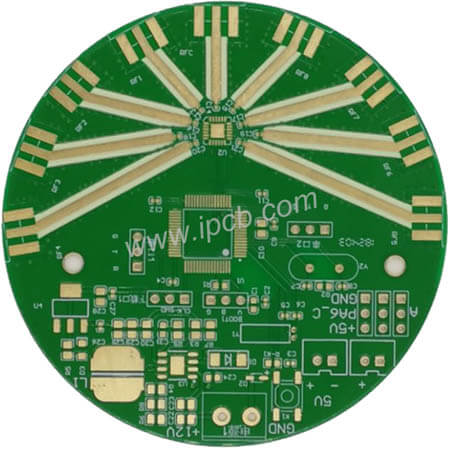1、Definition of high-frequency PCB board
High frequency PCB board refers to a special PCB board with high electromagnetic frequency, which is used for PCB in the fields of high frequency (frequency greater than 300 MHz or wavelength less than 1 m) and microwave (frequency greater than 3 GHz or wavelength less than 0.1 m). It is a PCB board produced on the microwave substrate copper clad laminate by using part of the process of the common rigid PCB board manufacturing method or using special processing methods.

2、Classification of high-frequency board
RO4350B/4003CArlon 25N/25FRTaconic TLG series B. Processing method: similar to epoxy resin/glass woven fabric (FR4. Rogers PCB material ceramic high-frequency PCB board series classification: RO3000 series: based on ceramic filled PTFE circuit materials, models: RO3003, RO3006, RO3010, RO3035 high-frequency laminate. RT6000 series: ceramic filled PTFE circuit material, designed for high dielectric constant electronic and microwave circuits, model: RT6006 dielectric constant 6.15/RT6010 dielectric constant 10.2. TMM series: composite materials based on ceramics, hydrocarbons, thermosetting polymers, models: TMM3, TMM4, TMM6, TMM10, TMM10i, TMM13i.
High frequency of electronic equipment is a development trend, especially with the increasing development of wireless networks and satellite communications, information products are moving towards high speed and high frequency, and communication products are moving towards the standardization of voice, video and data for wireless transmission with large capacity and fast speed. Therefore, the new generation of products need high-frequency baseboard. Communication products such as satellite systems and mobile phone receiving base stations must use high-frequency PCB board. In the next few years, it is bound to develop rapidly, and high-frequency baseboard will be in great demand.
(1) The thermal expansion coefficient of high-frequency PCB board substrate and copper foil must be consistent. If they are not consistent, the copper foil will be separated in the process of cold and hot changes.
(2) High frequency PCB board substrate should have low water absorption, and high water absorption will cause dielectric constant and dielectric loss when it is affected with moisture.
(3) The dielectric constant (Dk) of high-frequency PCB board substrate must be small and stable. Generally speaking, the smaller the better. The signal transmission rate is inversely proportional to the square root of the dielectric constant of the material. High dielectric constant is easy to cause signal transmission delay.
(4) The dielectric loss (Df) of high-frequency circuit board substrate material must be small, which mainly affects the quality of signal transmission. The smaller the dielectric loss is, the smaller the signal loss is.
(5) Other heat resistance, chemical resistance, impact strength and peel strength of high-frequency PCB board substrate materials must also be good. Generally speaking, high frequency can be defined as frequency above 1GHz. At present, the high-frequency PCB board substrate that is more commonly used is the fluorine dielectric substrate, such as polytetrafluoroethylene (PTFE), which is usually called Teflon and is usually used above 5GHz. In addition, FR-4 or PPO substrate can be used for products between 1GHz and 10GHz.
3、Difficulties in high-frequency PCB board processing
1) Copper sinking: the hole wall is not easy to copper;
2) Control of map turning, etching, line width gap and sand hole;
3) Green oil process: control of green oil adhesion and green oil foaming;
4) Scratches on the board surface shall be strictly controlled in each process.
Substrate materials need to have excellent electrical properties and good chemical stability. With the increase of power signal frequency, the loss on the substrate is required to be very small, so the importance of high-frequency PCB board is highlighted.